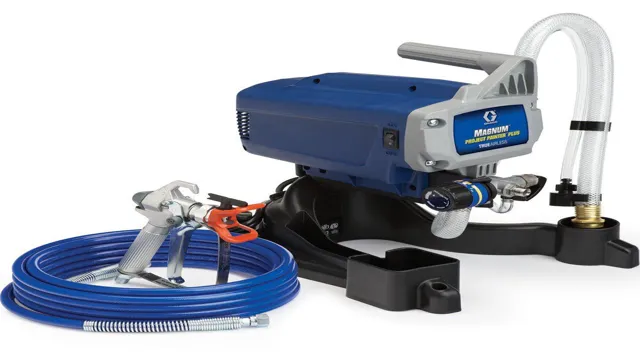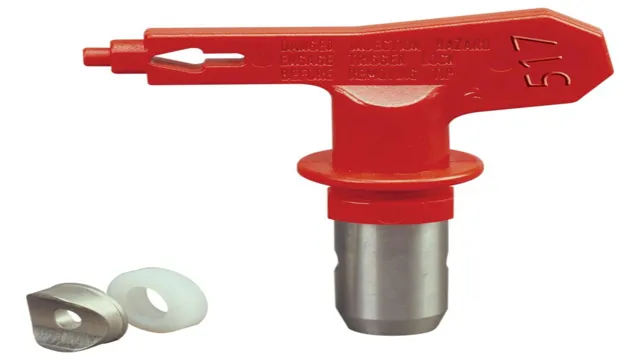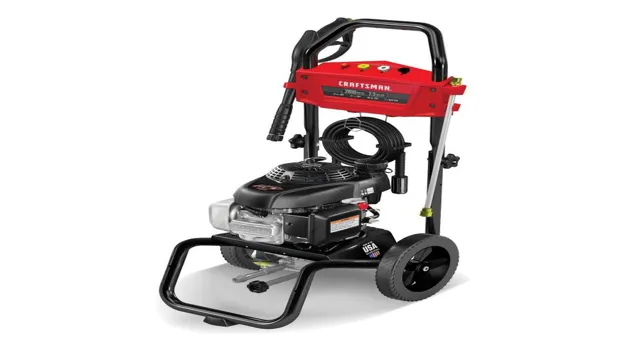What Kind of Paint Sprayer for Interior Walls: Tips and Tricks for Choosing the Right Tool

Choosing the right paint sprayer for interior walls can often be a daunting task, especially if you’re not well-versed in the intricacies of different models and types. The wrong choice can lead to uneven coverage, prolonged painting times, or even wasted paint. However, selecting the right paint sprayer can make all the difference in how your walls look and how much time and effort you have to put into the project.
In this blog, we’ll explore the various factors to consider when choosing a paint sprayer for interior walls, including the type of sprayer, the spraying technique, and the size of the project, ensuring you make the right decision for your needs and produce a beautiful finish. So, let’s get started!
Types of Paint Sprayers
When it comes to painting interior walls, the right kind of paint sprayer can make all the difference. There are several types of paint sprayers to choose from, each with its own unique set of features and benefits to consider. Airless paint sprayers are ideal for larger paint jobs, such as whole-room makeovers, while HVLP (high-volume, low-pressure) sprayers are better suited for smaller, more detailed work like trim and furniture.
For those looking for a more affordable option, air-powered sprayers can be a great choice. Ultimately, the best kind of paint sprayer for interior walls will depend on your specific needs and budget. Consider factors like the size of the job, the type of paint you’ll be using, and your own comfort level with each type of sprayer.
With the right tool at your disposal, painting your walls can be a breeze.
Airless Paint Sprayers
Airless paint sprayers are a popular choice for painting projects due to their ease of use and efficiency. There are two main types of airless paint sprayers: piston pumps and diaphragm pumps. Piston pumps are more commonly used and are generally more powerful, making them ideal for large-scale projects.
They use a piston to draw paint into the sprayer and force it out through the nozzle. Diaphragm pumps are designed for smaller, more precise jobs, as they use a diaphragm to transfer the paint from the container to the nozzle. Both types of airless paint sprayers are highly versatile and can be used for a variety of projects, from painting walls and ceilings to furniture and cabinets.
When choosing an airless paint sprayer, it’s important to consider the size of the project and the type of paint being used to ensure that the sprayer can handle the job efficiently. Overall, airless paint sprayers are a great investment for any DIYer or professional painter looking to save time and achieve a flawless finish.

HVLP Paint Sprayers
HVLP paint sprayers are a popular choice for those looking to tackle DIY projects or home improvements. When it comes to types of paint sprayers, there are three main options to consider: HVLP, airless, and compressed air. HVLP stands for High Volume Low Pressure.
These paint sprayers use a high volume of air at a low pressure to atomize the paint particles and create a fine mist. This results in less overspray and a more controlled application. HVLP sprayers are great for detail work and projects that require precise application.
Airless paint sprayers, on the other hand, use a high pressure to force the paint through a small tip, which creates a fan-shaped spray pattern. These sprayers are better suited for larger projects and thicker paints. Compressed air sprayers use compressed air to atomize the paint particles and apply the paint.
However, they tend to be less efficient and produce more overspray than the other two options. When deciding which type of paint sprayer to use for your project, consider the size of the job, the type of paint you will be using, and the level of detail required.
LVLP Paint Sprayers
Paint sprayers have greatly revolutionized the paint industry with their efficiency and convenience. There are several types of paint sprayers available in the market, each with its own unique features and benefits. One such type of paint sprayer is the LVLP paint sprayer, also known as the Low Volume, Low-Pressure paint sprayer.
Its main advantage lies in the fact that it uses less air pressure than traditional paint sprayers, making it a more eco-friendly option. Furthermore, the LVLP paint sprayer is also perfect for achieving precise and even paint coverage, making it an excellent choice for painting furniture or small items. By using smaller atomized droplets, LVLP paint sprayers produce less overspray, making them easier to use and more efficient than traditional paint sprayers.
They are also relatively easy to clean and maintain, making them a favorite among DIY enthusiasts and professional painters alike. With its impressive performance and user-friendly features, the LVLP paint sprayer is a great investment for anyone looking to achieve a flawless and even finish with their paint jobs.
Considerations When Choosing a Paint Sprayer
When it comes to painting your interior walls, choosing the right paint sprayer can make all the difference. There are a variety of types and models of paint sprayers to choose from, each with their own set of benefits and drawbacks. If you’re looking for ease of use and versatility, an airless paint sprayer may be your best bet.
These sprayers use high pressure to atomize the paint, creating a fine mist that evenly covers the surface without leaving brushstrokes or roller marks. On the other hand, HVLP (High-Volume Low-Pressure) sprayers use low pressure to deliver a high volume of paint, making them ideal for detailed work. Other factors to consider when choosing a paint sprayer for interior walls include the size of the project, the type of paint being used, and your personal level of experience.
Ultimately, the right paint sprayer will depend on your individual needs and preferences.
Size of Project
When it comes to choosing a paint sprayer, the size of your project is a vital consideration. Whether you’re a DIY enthusiast or a professional painter, selecting a sprayer with the correct size for your job can make all the difference in achieving a flawless finish. If you’re working on a small project like painting a single room or a piece of furniture, a compact handheld sprayer with a smaller capacity will suffice.
On the other hand, if you’re tackling more significant projects like painting a house exterior or multiple rooms in a home, you’ll want to invest in a larger paint sprayer that can handle the increased paint volume. Choosing the wrong size sprayer can lead to wasted time, effort, and paint, resulting in a subpar finished product. It’s essential to assess the size of your project and choose the appropriate paint sprayer size for the best possible outcome.
Type of Paint
When it comes to choosing the right paint sprayer, there are several considerations you need to take into account to ensure the best results. One important factor to consider is the type of paint that you’ll be using. Different types of paint require different spray tips and nozzle sizes, so it’s important to choose a sprayer that is compatible with your paint type.
For example, latex paint requires a larger tip size than oil-based paint, which can clog the nozzle if used with a sprayer designed for latex. Additionally, some paint sprayers may be better suited for specific types of paint, such as airless sprayers for thicker paints or HVLP sprayers for fine finishes. By taking into account the type of paint you plan to use, you’ll be able to choose a paint sprayer that will provide optimal performance and ensure a flawless finish.
Ease of Use
When you’re choosing a paint sprayer, ease of use should definitely be a consideration. After all, you want to make sure that the sprayer you purchase won’t leave you with frustrating errors or take hours to figure out how to use properly. Look for a paint sprayer that has intuitive controls and a clear instruction manual.
You’ll also want to pay attention to how easy it is to refill the paint container, as well as how easy it is to clean the sprayer after you’re finished with your project. By choosing a paint sprayer that is user-friendly, you’ll be able to spend less time making mistakes or struggling to get the sprayer to work correctly, and more time creating a beautifully painted finish.
Top Paint Sprayers for Interior Walls
When it comes to painting interior walls, the right paint sprayer can make all the difference. There are many options available, but the best type of paint sprayer for interior walls is an airless sprayer. Airless sprayers use high pressure to atomize the paint, which means they can cover more surface area in less time.
They are also great for applying thicker paints, such as latex, which are commonly used on interior walls. Some of the top paint sprayers for interior walls include the Graco Magnum X5, the Wagner Control Pro 130, and the Titan ControlMax 1700 Pro. These models are all easy to use, efficient, and produce a smooth, even finish.
Whether you’re a DIY enthusiast or a professional painter, investing in a quality airless paint sprayer can save you time and effort while delivering professional-looking results.
Graco Magnum X7 Airless Paint Sprayer
When it comes to painting interior walls, using the right paint sprayer can make all the difference. One of the top choices on the market is the Graco Magnum X7 Airless Paint Sprayer. This airless sprayer is designed to deliver a smooth, even coat of paint on walls and other surfaces, without leaving behind brush strokes or roller marks.
Its powerful motor allows for a high level of burstiness and paint output, making it efficient for large-scale painting projects. Additionally, its adjustable pressure control allows for precision and versatility, accommodating a range of paint types and finishes. With its ease of use and consistent results, the Graco Magnum X7 is a reliable choice for anyone looking to tackle their interior painting project with ease and efficiency.
Use this paint sprayer for a quick and efficient way to achieve a professional finish on any interior wall.
Wagner Control Spray Max HVLP Paint Sprayer
If you’re looking for the best paint sprayers for interior walls, the Wagner Control Spray Max HVLP Paint Sprayer is a top contender. This sprayer uses high-volume, low-pressure technology to deliver a smooth and even finish to walls and surfaces. It’s also easy to use and requires minimal setup, making it a great option for DIY projects and home renovations.
With a 20-foot hose and adjustable spray pattern, you can cover a large area quickly and efficiently. The sprayer is also versatile and can be used with a variety of paints, including latex, oil-based, and even thicker coatings like varnish and stain. Overall, the Wagner Control Spray Max HVLP Paint Sprayer is a reliable choice for anyone looking to tackle an interior painting project.
Campbell Hausfeld DH580000AV HVLP Paint Sprayer
If you’re planning on painting the interior walls of your home, choosing the right paint sprayer can make a significant difference in the outcome of your project. One of the top paint sprayers available on the market today is the Campbell Hausfeld DH580000AV HVLP Paint Sprayer. This sprayer comes equipped with a high volume low-pressure (HVLP) technology that provides a consistent and even spray pattern with reduced overspray, which means you’ll have less mess to clean up.
The sprayer also includes an adjustable spray pattern knob that allows you to switch easily between horizontal, vertical, and circular patterns, giving you greater control over the application. Plus, the durable stainless steel paint cup holds up to 20 ounces of paint, making it perfect for larger projects. Whether you’re a professional painter or a DIY enthusiast, the Campbell Hausfeld DH580000AV HVLP Paint Sprayer is an excellent tool for any interior painting project.
TCP Global Professional Gravity Feed LVLP Spray Gun
Paint sprayers are becoming increasingly popular for interior wall painting, and the TCP Global Professional Gravity Feed LVLP Spray Gun is a top contender on the market. This spray gun is designed for both professionalism and ease of use, allowing for precise control and even coverage. Its low-volume, low-pressure (LVLP) system helps reduce overspray and ensures maximum transfer efficiency, minimizing waste.
Its adjustable settings give users the flexibility to customize their spray pattern for various painting projects. Overall, the TCP Global Professional Gravity Feed LVLP Spray Gun is a reliable investment for anyone looking to tackle their interior painting projects with speed and precision.
Conclusion
In conclusion, choosing the right kind of paint sprayer for your interior walls is crucial in achieving a beautiful and long-lasting result. For a professional and precise finish, an airless paint sprayer is the way to go. But if you’re looking for a more cost-effective and versatile option, an HVLP paint sprayer may be your best bet.
Whatever your preference may be, remember that investing in a good quality paint sprayer is an investment in the overall appearance and value of your home. Happy painting!”
FAQs
What is a paint sprayer?
A paint sprayer is a tool used to apply paint or other coatings on surfaces using compressed air, high pressure, or other methods.
Why use a paint sprayer for interior walls?
Using a paint sprayer for interior walls can save time and effort compared to traditional methods such as paint rollers, and can provide a more even and professional finish.
What types of paint sprayers are available for interior walls?
There are several types of paint sprayers available for interior walls, including airless sprayers, HVLP (high volume, low pressure) sprayers, and handheld sprayers.
What is the best type of paint sprayer for interior walls?
The best type of paint sprayer for interior walls depends on the size of the project, the type of paint being used, and personal preference. HVLP sprayers are generally recommended for most interior wall projects.
Can a paint sprayer be used for textured walls?
Yes, paint sprayers can be used on textured walls, but it is important to choose a sprayer with a large enough tip to handle the texture and to prime the walls beforehand.
Is it necessary to thin paint before using a sprayer on interior walls?
It depends on the type of paint and the sprayer being used. Some sprayers may require thinning while others can handle thicker paints without issue.
Can beginners use paint sprayers for interior walls?
Yes, beginners can use paint sprayers for interior walls with some practice and research. It is important to follow safety guidelines and properly prepare the workspace before starting.







